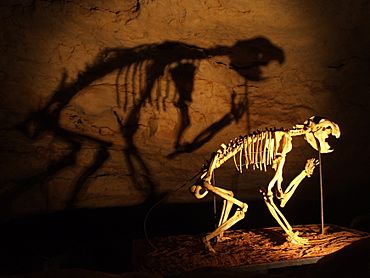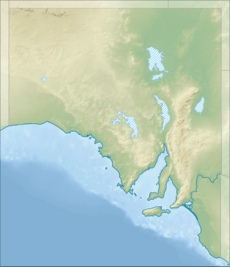Naracoorte Caves National Park facts for kids
Quick facts for kids Naracoorte Caves National ParkJoanna & Mount Light, South Australia |
|
|---|---|
|
IUCN Category II (National Park)
|
|

Skeleton of a marsupial lion (Thylacoleo carnifex) in the Victoria Fossil Cave
|
|
| Nearest town or city | Naracoorte |
| Established | Conservation Park 27 April 1972 National Park 18 January 2001 |
| Area | 6.60 km2 (2.5 sq mi) |
| Visitation | 90,812 (in 2022) |
| Managing authorities | Department of Environment and Water |
| Website | Naracoorte Caves National Park |
| Footnotes | |
 |
|
| UNESCO World Heritage Site | |
| Part of | Australian Fossil Mammal Sites (Riversleigh/Naracoorte) |
| Criteria | Natural: viii, ix |
| Inscription | 1994 (18th Session) |
| Area | 300 ha |
| See also | Protected areas of South Australia |
Naracoorte Caves National Park is an amazing place in the south-east of South Australia. It's famous for its incredible collection of fossils. In 1994, it was recognized as a World Heritage Site because of these fossils, along with another site called Riversleigh.
The park protects about 6 square kilometers of natural land. Within this area, there are 26 caves. Only four of these caves are open for people to visit. The other caves are kept private for scientists to study and to protect their precious contents. Many of the caves also have beautiful stalactites and stalagmites.
Contents
History of the Caves
How the Caves Were Found
The caves we now know as part of the national park were first discovered in 1845. The first one found was called Blanche Cave.
Finding Ancient Fossils
The first time people officially collected ancient animal fossils from the caves was in 1908. A person named William Reddan found many large fossils from the Pleistocene era in Specimen Cave. These fossils came from huge animals that lived long ago.
Becoming a Tourist Spot
In 1916, the area with many of the caves became a "national pleasure resort." This meant it was managed to attract visitors and tourists. The park became even more popular in 1969. That's when scientists found the biggest collection of ancient Australian animal fossils in Victoria Cave!
Protecting the Caves
On April 27, 1972, the area was officially named the Naracoorte Caves Conservation Park. This change helped protect the caves and their important contents even more.
A World Heritage Site
On December 17, 1994, a special part of the park, covering 300 hectares, was added to the World Heritage List. This was because of its amazing fossil record. It joined the Riversleigh fossil site in Queensland to form the "Australian Fossil Mammal Sites." This listing means the caves are important for everyone in the world to protect.
Naracoorte Caves National Park
On January 18, 2001, the conservation park became the Naracoorte Caves National Park. This new name showed how important the natural features of the land truly are. In 2007, the Australian Fossil Mammal Sites were also added to the Australian National Heritage List, making their protection even stronger.
Exploring the Caves
Naracoorte Caves National Park is a fantastic place to visit! You can stay at the camping ground or caravan park, or even in dormitory rooms if you're with a group. There are also picnic areas and a cafe.
- Guided Tours: You can take tours led by experts through the beautiful caves. Some tours even take you to see the amazing fossil deposits up close.
- Bat Cave: Modern technology lets visitors see inside the Bat Cave. Thousands of southern bent-wing bats live and breed there every year.
- Fossil Centre: The park's visitor center, called the Wonambi Fossil Centre, has cool displays. You can see fossils and bones found in the caves. There are also models of the extinct animals that once lived here.
How the Caves Formed and Why They Have Fossils
The rocks that make up the caves were formed from coral and sea creatures. This happened millions of years ago when the land was under the sea. Over time, rainwater slowly dissolved the limestone rock. This created the amazing caves we see today.
Many of the caves are not far below the ground. Sometimes, holes opened up in the ground, creating traps. Animals like ancient mammals would fall into these holes and couldn't get out. Over thousands of years, their bones were covered by dirt and sand. This created the incredible fossil record we find today. In some places, the fossil layers are up to 20 meters thick!
These "fossil traps" are super important for understanding Australian megafauna. Megafauna were huge animals, much bigger than animals today, that lived in Australia long ago. Scientists are still studying these fossils to learn more about Earth's past. We now know that these caves started forming at least 1.34 million years ago!
See also
 In Spanish: Parque nacional Cuevas de Naracoorte para niños
In Spanish: Parque nacional Cuevas de Naracoorte para niños
- Protected areas of South Australia
- List of World Heritage Sites in Oceania
- List of fossil parks


